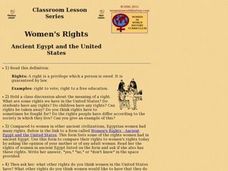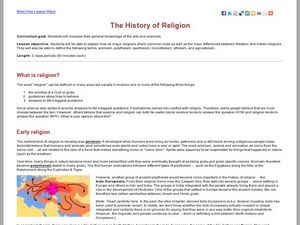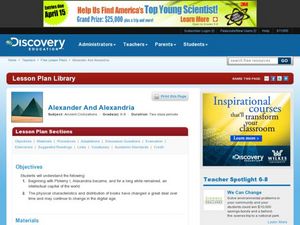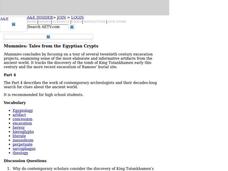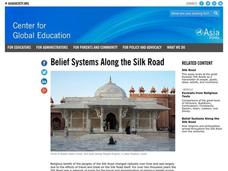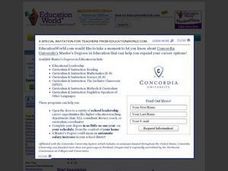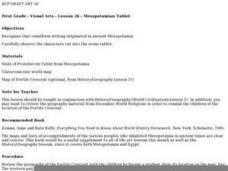Curated OER
Women's Rights Ancient Egypt and the United States
Students explore the rights of women in the United States and ancient Egypt. Comparisons between the two eras and countries are made as the wealth, business, marriages, court cases, divorces, and employment of women are probed.
Curated OER
Design an Egyptian Playground
Middle schoolers are broken up into four groups. Each group will use their knowledge about Egypt to originate a playground for Egyptian children. This will involve brainstorming ideas on paper, building a prototype with Legos or other...
Curated OER
Exploring & Creating Mythology
Learners read and compare mythological stories from ancient cultures from around the world. In small groups they read a myth and present the storyline and themes to the class, and write an original mythological story of their own...
Curated OER
Prayers for Paankhenamun
Students use the internet to research one of six Egyptian gods and goddesses of the afterlife. They focus on physical attributes, symbols associated with and the role played by that deity into the afterlife. They write a letter to their...
Curated OER
Augustus: First of the Roman Emperors
Students explore how Julius Caesar's military brilliance forged a new Rome, but Augustus' political genius made it an empire for the ages. Despite being Caesar's nephew and adopted heir, Augustus struggled for thirteen years to...
Curated OER
The Persian Empire
In this the Persian empire worksheet, students read a two page passage about Persia, then answer 5 multiple choice and 7 short answer questions requiring research about the topic.
Curated OER
The History of Religion
Students learn about the two main types of religions. In this religion lesson, students define religion and learn about early religion as well as religion in the west. Students define animism, polytheism, pantheism,...
Curated OER
Thematic Amusement Park Projects
Theme park lesson plans help students learn about history, science, and have fun at the same time.
Curated OER
The Uluburun Shipwreck Project: Interconnections through Trade in the Late Bronze Age Mediterranean World
Ninth graders examine causes and effects of the Uluburun shipwreck. In groups, they develop their own ways to categorize the artifacts found on the ship and decide on the research questions they are going to focus on. They use the...
Curated OER
Alexander and Alexandria
Students explore the history of libraries. In this ancient civilizations lesson, students consider the work of Ptolemy to build a library in Alexandria. Students discuss the availability of books then and today. Students also discuss how...
Curated OER
Elements of Civilization
High schoolers create their own ancient civilizations based off of topographical maps of Egypt, Mesopotamia, the Indus Valley, and the Yellow River. In this social studies lesson, students are assigned one topographical map to use to...
Curated OER
Mummies: Tales from the Egyptian Crypts Part IV
Students choose one or two of the artifacts found in King Tutankhamen's tomb and describe and analyze the artifact. Explain what it tells us about Tutankhamen's life and about ancient Egyptian culture.
Curated OER
Location of Cities 201
Students work in pairs to locate the ancient cities on a world atlas using the longitude and latitude measurements. They examine the physical and human futures that explain their locations.
Curated OER
The Empires of Early Africa
Students view the video "Empires of Early Africa." They are asked: Who was Nefertiti? They review the facts about Akhenaten and Nefertiti. Students discuss how archaeologists looked for clues to determine the identity of the mummy...
Curated OER
Belief Systems Along the Silk Roads
Students reflect on similarities and differences among belief systems. Using excerpts of translated religious texts, they organize these quotations into broad themes. The quotations will be posted on a Silk Roads map as reminders of how...
Curated OER
Ancient Egypt Artifacts: Birmingham Museums and Art Gallery Learning and Outreach
In this Egyptian artifacts learning exercise, students study photographs and information from the Birmingham Museum. There are 23 pages, each with a color photograph of an actual artifact and background information. There are no questions.
Curated OER
Make A Mummy: The Science of Mummification
Learners research the history of mummification. They work together to create an apple mummy. They write a paragraph about what they gathered while doing the experiment.
Curated OER
Mesopotamian Tablet, Egyptian Art
First graders examine cuneiform writing from a stone tablet, then write a simple sentence using pictographs. They analyze various examples of Egyptian art, construct a model of an Egyptian boat, and create a class painting using glyphs...
Curated OER
Who Built the Pyramids?
High schoolers examine the two theories on how the pyramids at Giza were built. They watch a video on pyramids, take notes, and write a five-paragraph essay on how they think the pyramids were constructed.
Los Angeles Unified School District
River Systems
Scholars must react to the ecosystems of a river. They use inquiry-based learning along with maps and visuals to better understand the impact of rivers on everyday life. To finish, they create final written projects and presentations.
Curated OER
Role Playing the Plague
Students investigate the impact of the plague. In this European history lesson, students listen to their instructors present information regarding the black death and then write letters regarding the plague from the perspective of 14th...
Curated OER
Moses and the Ten Commandments
Students watch a video about Moses and the Ten Commandments; participate in discussion; create a replica table of the Ten Commandments, or create a picture illustrating the parting of the Red Sea.
Curated OER
Egyptian Expedition
Students identify and analyze ancient Egypt and interpret how to develop bibliographical references. They research topics using multiple resources and various forms of media of media. Finally, students practice and deliver an oral...
Curated OER
The Chinese Produce Paper as We Know it Today
Tenth graders explore where paper originated and its importance from the Chinese to the rest of the world. They list ten ways that they use paper on a daily basis and rate that use on a scale from one to ten. Each group also brainstorms...
